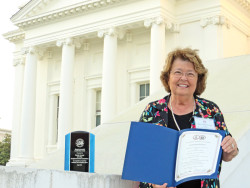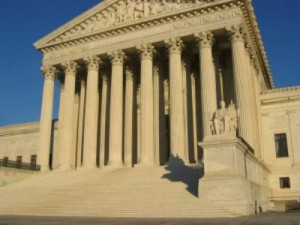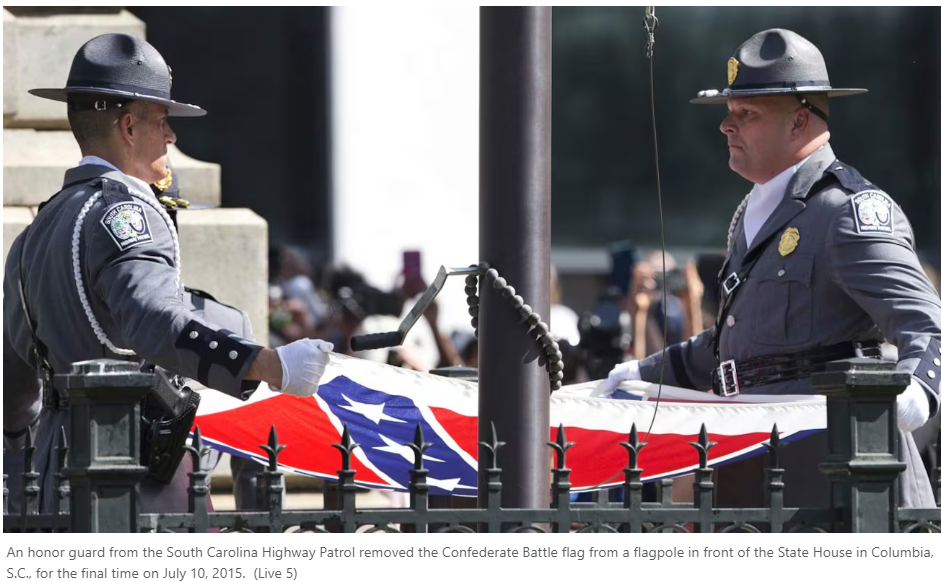VIRGINIA: Pulaski Sesquicentennial Committee Honored
As the months are counting down to the halfway point for 2015, the five-year commemoration for the 150th anniversary of the Civil War is also coming to a close. It’s been going on statewide, involving many different counties commemorating the Civil War battlefields, trails and events that were part of their local history, including, of course, Pulaski County and the Battle of Cloyd’s Mountain.
The Pulaski County Civil War Sesquicentennial Committee was one of 17 committees in Virginia to recently receive the Sesquicentennial Leadership Award. Mary Catherine Stout, who leads the committee, accepted the award on the group’s behalf, which was presented at a special “Finale Concert” ceremony at the Virginia State Capitol in Richmond on Memorial Day.
“We’ve worked for many years and participated in events to commemorate the Civil War,” Stout said. “That time has come to a close.”
The Pulaski County Sesquicentennial Committee’s involvement in Civil War commemoration events dates back to 2009. Events have included the 150th anniversary reenactment of the Battle of Cloyd’s Mountain last year, as well as the “End of Civil War” event held at the Wilderness Regional Road Museum in April.
The Montgomery County Civil War Sesquicentennial Committee was one of the recipients of the award as well. The Roanoke Valley Sesquicentennial Committee nearby was also honored with the Sesquicentennial Leadership Commendation Award.
The 150th anniversary event to commemorate the end of the Civil War included a performance by the Roanoke Symphony Orchestra, which performed tunes from the era. Civil War scholar and Virginia Tech professor James Robertson spoke at the event, telling a story about the history and significance of each song before they were performed.
Stout said she and fellow committee member Sharon Hardy compiled a report to encompass the event, along with help from Carol Smith and the Pulaski County Library System.
According to Stout, this marks the end of the Sesquicentennial Committee’s primary purpose. However, that doesn’t mean their work will end there. Stout said the committee will focus on a far-reaching project to preserve Pulaski County’s Civil War sites.
“We’re looking toward the future to promote Civil War history in Pulaski County,” Stout explained. “This is about more than just that one battlefield.”
This will mean a name change, as well as a different approach to the committee’s work, which Stout says will, more than likely, be in the form of a foundation.
-southwesttimes.com
###
TEXAS: Supreme Court Decision Expected Soon on Confederate License Plate
From Obamacare to same-sex marriage, the Supreme Court has some big decision to announce in the next four weeks. Here is your quick guide as the first decisions are set to be announced in June.
For now, the Court has four decision, or non-argument, days scheduled, until late June. It will undoubtedly add a few more decision days to its calendar, if it follows recent trends.
Here is a quick look at the major decisions pending before late June, when the Court is expected to end its 2014 term. The decisions are listed by when arguments were heard by the Justices.
PENDING DECISIONS
Zivotofsky v. Kerry (heard November 3, 2014)
Zivotofsky v. Perry involves 12-year-old Menachem Binyamin Zivotofsky. Menachem’s parents are American citizens, and Menachem was born in Jerusalem. The Zivotofskys asked the State Department for a passport for Menachem that listed “Jerusalem, Israel,” as his birthplace. The State Department refused to add the word “Israel” to Menachem’s passport, and the dispute has been in the legal system since then.
The direct constitutional issue is Zivotofsky is the question of which branch of government controls all, or at least most, of the foreign policy decisions in Washington.
Reed v. Town Of Gilbert, Arizona (heard January 12, 2015)
This case is about local zoning laws that pertain to temporary signs that give directions to where people can attend church services. The Court accepted the case in July 2014 and it involves the zoning ordinance in Gilbert, which draws a distinction between “ideological signs” and “political signs” posted in publicly viewed locations. The Gilbert code restricts religious signs to 6 square feet, while political signs can be up to 32 square feet in size. There are also different time restrictions. A lower court decided the Gilbert code was “content neutral.” The Justice Department supports the church in this case.
Texas Department of Housing v. Inclusive Communities Project (heard January 21, 2015)
The case began in 2008, when the Inclusive Communities Project (or ICP) filed a lawsuit against the Texas state agency for the distribution of tax credits in a way that reinforces and increases racial segregation. Because landlords who receive the tax credits are required to accept affordable-housing vouchers from low-income tenants—many of whom come from minority communities—the allocation of those credits has an outsized impact on racial housing patterns. Courts at the district and circuit levels agreed with the ICP, concluding that Texas’ distribution of tax credits violated the Fair Housing Act because of its “disparate impact” on minorities.
Arizona State Legislature v. Arizona Independent Redistricting Commission (heard March 2, 2015)
Proposition 106, passed in 2000 by 56 percent of Arizona voters, established a statewide, bipartisan committee to oversee the redistricting process for state and congressional seats. Perhaps unsurprisingly, partisan bickering has roiled the committee’s decisions. The GOP-controlled state legislature is hoping the Supreme Court will return control to Phoenix. But a ruling in favor of the bipartisan committee could have far-reaching effects about redistricting – if the Court decides the Arizona legislature has standing to sue.
King v. Burwell (heard March 4, 2015)
The case of King v. Burwell is a significant challenge to the Affordable Care Act, or Obamacare. The Justices will try to decide if language in the act blocks people from getting tax breaks on premiums sold by federally run health-care exchanges in 34 states.
The tax credits go to people who most likely can’t afford to buy insurance at full prices on the exchanges. So a ruling that holds the subsidies are unconstitutional could have a big effect on Obamacare’s future.
Walker v. Sons of Confederate Veterans (heard March 23, 2015)
Walker III V. Texas Division, Sons Of Confederate Veterans, Inc., will settle a dispute about the boundaries between government speech and free speech. The Texas case came about in 2009, when the Texas Sons of Confederate Veterans (or SCV) submitted an application to the state’s specialty license program for a plate design that featured the Confederate battle flag. The Texas Department of Motor Vehicle Board voted to decline the application, citing a policy that it “may refuse to create a new specialty license plate if the design might be offensive to any member of the public.”
Obergefell v. Hodges (heard April 28, 2015)
The Supreme Court heard extended arguments last week about the legality of same-sex marriages in four states. Its eventual decision could be a landmark civil rights moment, or a move that would confuse a lot of people on both sides of the issue. Same-sex marriage supporters believe the unions are permitted nationally under the Constitution’s Due Process and Equal Protection provisions. But four states in this lawsuit – Ohio, Michigan, Kentucky and Tennessee – believe same-sex marriage eligibility should be determined by the states, through a political process that gives voters a role in the decision.
Glossip v. Gross (heard April 29, 2015)
Glossip v. Gross is a case was brought by several death-row inmates in Oklahoma, who claim that the use of midazolam, an anti-anxiety medication, as a sedative during lethal injection violates a prisoner’s Eighth Amendment right to be free from cruel and unusual punishment.
CASES DECIDED
Elonis v. United States (heard December 1, 2014; decided June 1, 2015)
Elonis vs. United States is a case originating near Bethlehem, Pennsylvania. Anthony Elonis was challenging a 44-month prison sentence for posts on Facebook that appeared to threaten his wife with violence, including statements made by Elonis online after he was served with a protection-from-abuse order.
In a majority 7-2 opinion written by Chief Justice John Roberts, the Supreme Court said that the lower court that convicted Elonis needs to rehear the case after not requiring evidence the threats were made with malice.
On first blush, the decision seems to be a victory for free speech advocates. But the ruling was on statutory (and not First Amendment) grounds and Anthony Elonis may still see his conviction stand if a retrial results in an opinion that Elonis’s Facebook statements were made with a “subjective intent to threaten.”
EEOC v. Abercrombie & Fitch (heard February 25, 2015; decided June 1, 2015)
Samantha Elauf applied to work for the famous clothing retailer but was rejected. The EEOC took up the case, contending that Elauf, a Muslim, was denied employment because she wears a headscarf. But the agency lost in the Tenth Circuit and was asking the Supreme Court to intervene.
A near unanimous Supreme Court said that the lower court didn’t properly interpret Title VII of the Civil Rights Act.
Link: Read The Decision
Justice Antonin Scalia said in an 8-1 majority opinion that “an employer is surely entitled to have, for example, a no-headwear policy as an ordinary matter. But when an applicant requires an accommodation as an ‘aspec[t] of religious . . . practice,’ it is no response that the subsequent ‘fail[ure] . . . to hire’ was due to an otherwise-neutral policy. Title VII requires otherwise-neutral policies to give way to the need for an accommodation.”
–blog.constitutioncenter.org
###
VIRGINIA: Civil War Trust Raises $52 Million
RICHMOND, Va. — The Civil War Trust has surpassed its $40 million goal in a campaign to protect 64 battlefields in 16 states, raising $52 million over four years.
The national nonprofit group announced Saturday at its annual conference that its effort to save battlefields during the war’s just-concluded 150th anniversary was a success. The goal of the “Campaign 150: Our Time, Our Legacy,” was to protect more than 10,000 acres of battlefields.
A majority of the preserved land is in Virginia, with key parcels at Chancellorsville and the Wilderness.
Since its creation in Fredericksburg in 1987, the trust has preserved 41,000 battlefield acres in 20 states—most recently including nearly 600 acres at Mill Springs, Mississippi.
–Associated Press
###
VIRGINIA: Civil War Trust Recognizes Preservationists
RICHMOND, Va. — Saving battlefields takes many hands pulling together.
No outfit knows that better than the Civil War Trust, so the nonprofit group takes pains to thank the people who hit the beach and fight through the hedgerows.
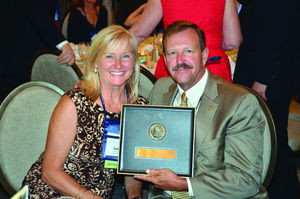
Photos by BRUCE GUTHRIE/CIVIL WAR TRUST
Virginia conservation chief Clyde Cristman, with wife Sandy, holds the trust award he accepted on behalf of his boss, Virginia Natural Resources Secretary Molly Ward.
Chief among them in recent years are Molly Ward, Virginia’s secretary of natural resources, and Journey Through Hallowed Ground Partnership President Cate Magennis Wyatt, the trust said this weekend during its annual conference.
The 50,000-member trust singled them out for national recognition, presenting its State Preservationist of the Year Award to Ward and its Preservation Legacy Award, given only on occasion, to Wyatt.
Trust President Jim Lighthizer, who served years ago as Maryland’s secretary of transportation, called Ward one of the best two state cabinet officers he has seen in 35 years.
“She’s that good,” Lighthizer said in announcing the award at a Saturday-evening banquet attended by more than 400 trust members from the U.S. and abroad.
He credited Ward, a former Hampton mayor and White House staff member, with preserving Fort Monroe and securing state support for the trust’s preservation work in Virginia. Lighthizer lauded her for “cutting through all the red tape and balderdash that is so typical in any state government.”
Because Ward was away on state business, Lighthizer entrusted her award—the breastplate from a Civil War soldier’s uniform—to Clyde Cristman, director of the state Department of Conservation and Recreation.
“She really is excited by all the things that you have accomplished,” Cristman told trust members. “We’ve got about two and a half years left in the [Gov. Terry] McAuliffe administration, so we’ve got a lot of work to do.”
Lighthizer said that Wyatt took “The Journey,” a national heritage area, from being “nothing” to a dynamic four-state enterprise with 350 private and governmental partners.
He recalled that “there was not much progress” as the nonprofit began.
“Then, Cate came along,” Lighthizer said. “And, man, has it all changed. It is a terrific organization.”
Extending from Gettysburg to Monticello along U.S. 15 (through Warrenton, Culpeper and Orange), the 180-mile-long heritage area tries to raise awareness of the unparalleled American heritage in that region.
Among its many initiatives is an ambitious Living Legacy Project that aims to plant one tree along the roadway for every Confederate and Union soldier who died during the Civil War.
“John Kennedy said that ‘a nation reveals itself not only by the men it produces, but also by the men it honors, the men it remembers,’” Wyatt said in thanking trust members for her honor. “Because of you, 620,000 who perished are remembered. And the towns and the counties and the people and the families will never be forgotten.”
Finally, the trust débuted a video depicting some of the 10,000-plus acres its members have saved during the Civil War sesquicentennial.
Mixing footage of drone flyovers, battle re-enactments and preservationists at work, the eight-minute documentary—produced by Wide Awake Films—includes scenes from Virginia’s Chancellorsville, Brandy Station, Wilderness, Cedar Mountain, Gaines’ Mill and Appomattox battlefields.
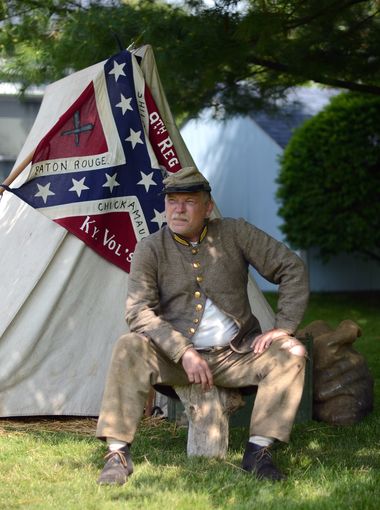
John McIntosh, of Royal Oak, said he participants for the camaraderie and to remember his ancestors. What he enjoyed most was answering questions from the public, Sunday, June 7, during the Lexington Civil War Festival. (Photo: ANDREW JOWETT, TIMES HERALD)
Christian Allen, 9, of Stockbridge, was living a civilian life along the water in downtown Lexington with his family.
“I’m a General now,” Christian said. “I like playing war games with the other kids and I caught a fish yesterday.”
Christian’s mother, Helga, 30, was cooking eggs over a campfire Sunday morning outside of the family’s canvas tent. She was wearing black boots beneath her hoop skirt and work dress.
“We are representing our ancestry this weekend,” said Ian Allen, 33. “My (great-great) uncle came out of the eastern part of Kentucky. His family were dirt farmers and they didn’t own any slaves, but they fought in the war because their land was being invaded, so they fought to save their land and because my uncle’s father was killed by a Yankee.”
Anita Ruffin, Civil War Encampment organizer, said she started the festival because she wanted to bring her love of civil war history to the village.
“As new youth comes along they really aren’t familiar with how people lived during the Civil War,” Ruffin said. “It’s an informal weekend where kids and adults can go up to the reenactors and ask lots of questions.”
Ed Carleton, 72, of Lexington, appreciated that the reenactment weekend taught the truth of the Civil War.
“Over 600,000 Americans lost their lives during the Civil War,” Carleton said. “No one today has any conception of that impact. Brothers and fathers fought side-by-side and died. The war wasn’t just about slavery, but about politics, rights, honor and land, and I hope this weekend is able to teach more than what kids learn in school about the war.”
The two day festival featured artifact displays, cannon firing, firearms demonstrations, and small battles.
Each reenactor camped in a small canvas tent – some were fully enclosed, others were open to the night air.
“It’s a great way to experience what the soldiers went through,” said Brian Kirk, 53, of Livonia. “It’s enlightening because those patriots went through a lot of difficult times, and even this reenactment is a luxury compared to what they experienced.”
While Kirk and his confederate camp-mates cooked their food over a campfire, but still admitted to using a porta-potty and stopping in at a local Lexington restaurant for breakfast Sunday morning.
“We research everything, down to the button holes on our uniform, to make sure everything is correct,” Kirk said. “But we are still modern men who are used to certain amenities. This is only a weekend we are trying to live like this, those soldiers lived for five years like this.”
–Lexington Times-Herald
###

